Statue of George Mason and George Mason University
Introduction
Text-to-speech Audio
Images
Aerial view of the Johnson Center on the Fairfax campus; image by Nicolas Tan/Creative Services/George Mason University - Photo Services | George Mason University, CC BY-SA 4.0, https://commons.wikimedia.org/w/index.php?curid=40992622
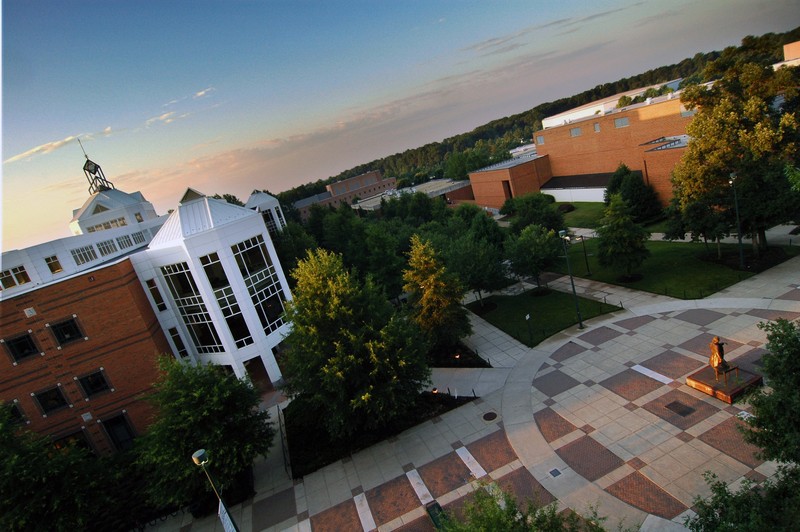
Statue of George Mason in front of the Johnson Center; image by Lucien Dalarun - Own work, CC BY-SA 3.0, https://commons.wikimedia.org/w/index.php?curid=22717714
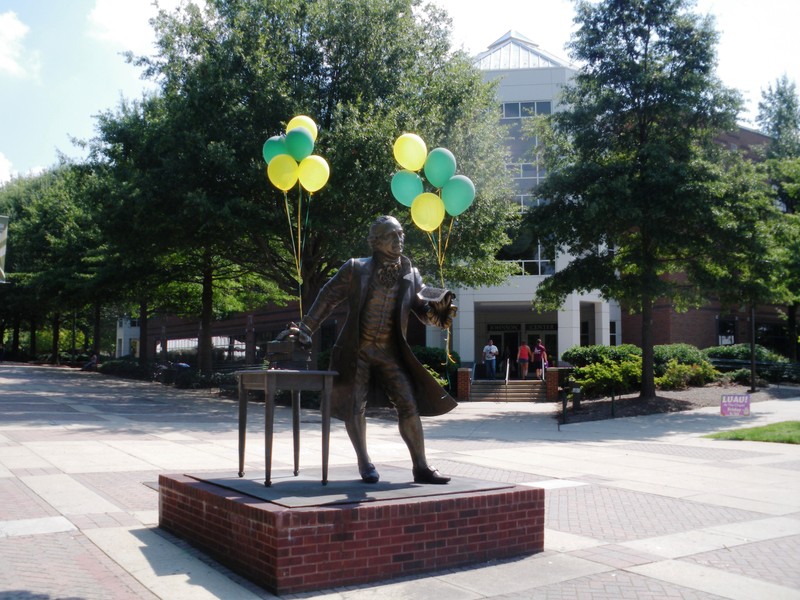
(April 7, 1972) Governor A. Linwood Holton signs H-210 separating George Mason College from the U.Va; George Mason University Photograph Collection, 1950s-1999 Box 2, Folder 9, CC BY-SA 4.0, http://commons.wikimedia.org/w/index.php?curid=40992649
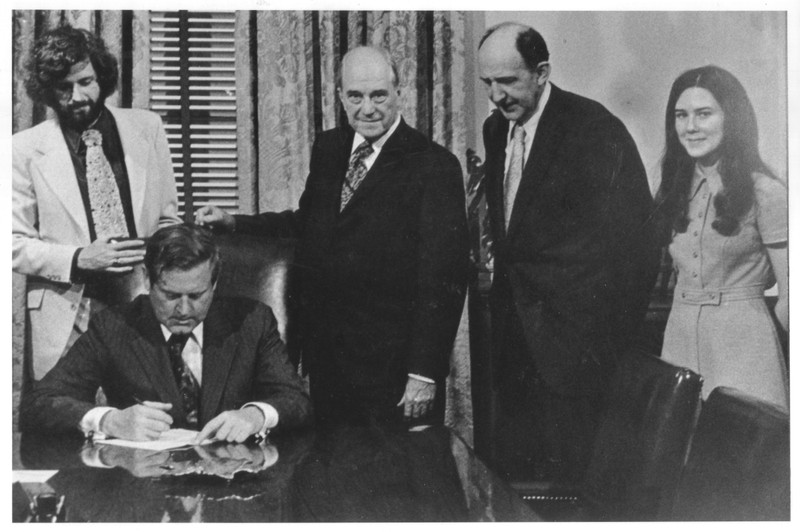
George Mason University Seal, from George Mason University's Visual Identity Guide
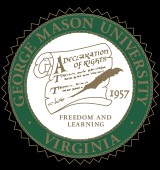
George Mason University Logo, from George Mason University's Visual Identity Guide
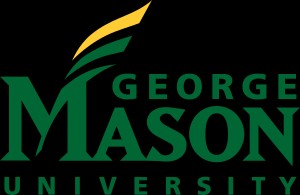
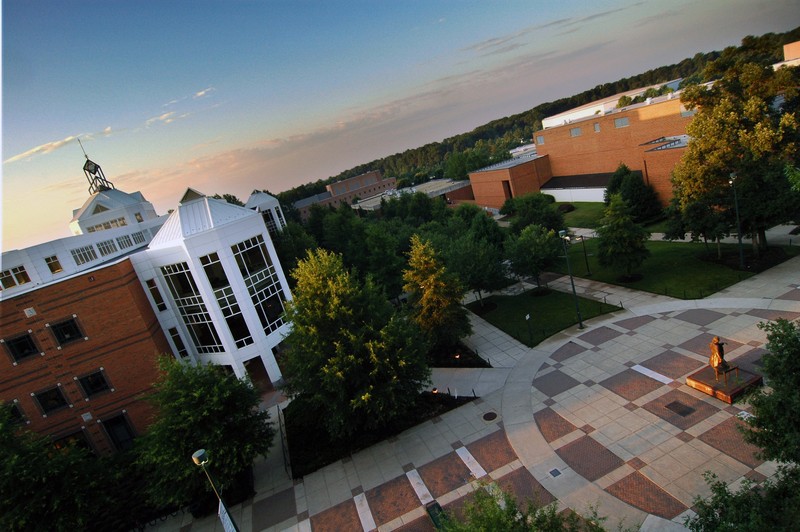
Backstory and Context
Text-to-speech Audio
The bronze statue, created by Wendy M. Ross, stands seven and half feet tall. It was dedicated in 1996. It depicts Mason holding his Virginia Bill of Rights, with one hand on a writing table copied from an existing table that remains in Gunston Hall, Mason's estate. The books on the table in the statue cite Locke, Rousseau, and Hume, some of Mason's influences.
George Mason University (GMU) is the largest public research university—and the largest university by enrollment numbers—in the Commonwealth of Virginia. In addition to the Fairfax location, George Mason University also has campuses in Arlington, Prince William, Fort Royal, and Songdo, South Korea.
In 1949, the University of Virginia (Charlottesville) opened an extension center within the halls of Washington & Lee High School in Arlington. This facility would allow U.Va to gain traction in northern Virginia and demonstrate that there was a demand for a higher education in the area. The U.Va Northern Virginian University Center offered informal classes and courses for credit, such as "Government in the Far East," "Introduction to International Politics," "English Composition," "Principles of Economics," Mathematical Analysis," "Introduction to Mathematical Statistics," and "Principles of Lip Reading."1 By 1956, growing enrollment numbers encouraged the Virginia General Assembly to convert the extension center into University College, a North Virginia branch of U.Va.
Much of the credit for the establishment of GMU is the result of the efforts of Charles Harrison Mann, Jr. As President of the Northern Virginia Chapter of the University of Virginia Alumni Association, Mann advocated for the development of a college system in the region. In his words, GMU “was birthed with the help of several midwives,"2 including figures such as U.Va President Colgate W. Darden, Jr.; U.Va Extension Division chief George B. Zehmer; Head of U.Va’s Northern Virginia University Center, John Norville Gibson Finley; Clarence A. Steele; and Fairfax Mayor, John C. Wood. Mann would go on to serve as the Chairman of George Mason College's first Board of Control, as well as on the George Mason University Board of Visitors.
In 1959, the Board of Visitors chose a permanent name for the North Virginia branch: George Mason College. Construction began in early 1960 on land donated by the city of Fairfax. The college opened its doors to its first class of 356 students in the fall of 1964. Several years later, a bill to make George Mason College a 4-year university was introduced by James M. Thomson to the Virginia General Assembly. Measure H 33 passed and, under the direction of U.Va, George Mason College became a degree-granting institution. Virginia Governor A. Linwood Holton signed Virginia General Assembly Bill H 210 on April 7, 1972. With this measure, George Mason College formally separated from U.Va and became George Mason University.
Today, GMU is the largest public research university in Virginia. The Fairfax campus spans 677 acres and is located approximately 20 miles from Washington, D.C. Its notable buildings include the Johnson Center, which features a library, dining establishments, shops, and more. Other significant facilities include the Center for the Arts, a 2,000-seat concert hall, the Long and Kimmy Nguyen Engineering Building, Exploratory Hall, the Art and Design Building, the Fenwick Library, and the Krasnow Institute for Advanced Study.
Academically, GMU is accredited by the Commission on Colleges of the Southern Association of Colleges and Schools to award bachelor's, master's, and doctoral degrees. Mason offers 81 undergraduate degrees, 88 master's degrees, and a law degree. The university is particularly recognized for its economics, law, creative writing, computer science, and business programs. It is ranked among the highest research institutions by the Carnegie Classification of Institutions for Higher Education. Prominent alumni and faculty members include such figures as James M. Buchanan and Vernon L. Smith—1986 and 2002 Nobel Prize Winners for Economics, respectively.
GMU also boasts a robust athletics program, competing under in Division I of the National Collegiate Athletic Association. Student athletes participate in 33 men's and women's Division I sports: baseball, basketball, cross-country, golf, lacrosse, rowing, soccer, softball, swimming and diving, tennis, indoor and outdoor track and field, volleyball, and wrestling. Its intercollegiate teams are members of the National Athletic Association Division I, the Atlantic 10, the Eastern College Athletic Conference, the Eastern Intercollegiate Volleyball Association, the Eastern Wrestling League, and the Intercollegiate Association of Amateur Athletes of America.
In addition to the Fairfax campus, George Mason University also has three other campuses in the state of Virginia, located in Arlington, Front Royal, and Prince William. In 2014, a fifth campus was opened in Songdo, within South Korea's Incheon Free Economic Zone. GMU's official colors are green and gold colors; the University mascot is The Patriot.
Sources
1. "George Mason University." Wikipedia, the Free Encyclopedia. Accessed January 17, 2017. https://en.wikipedia.org/wiki/George_Mason_University.
2. "A History of George Mason University | 1949-1954: The Idea : Introduction." George Mason Univerity Libraries. Accessed January 17, 2017. http://ahistoryofmason.gmu.edu/exhibits/show/idea/contents/introduction2ch1.
"A History of George Mason University." George Mason University Libraries. Accessed January 17, 2017. http://ahistoryofmason.gmu.edu.
George Mason University. George Mason Statue, Mason Explorer. Accessed November 3rd 2019. https://eagle.gmu.edu/map/buildings/statue.php.
